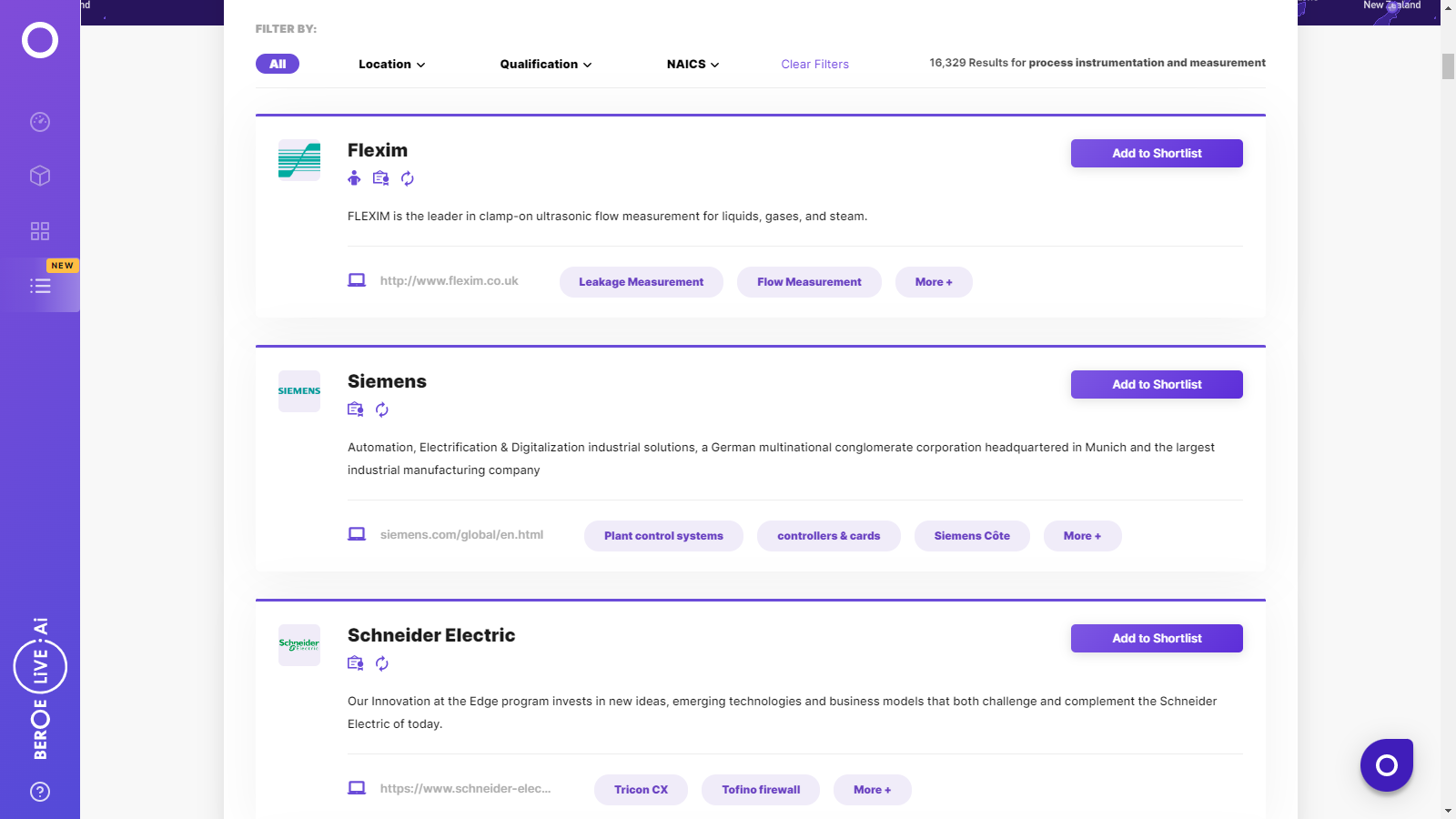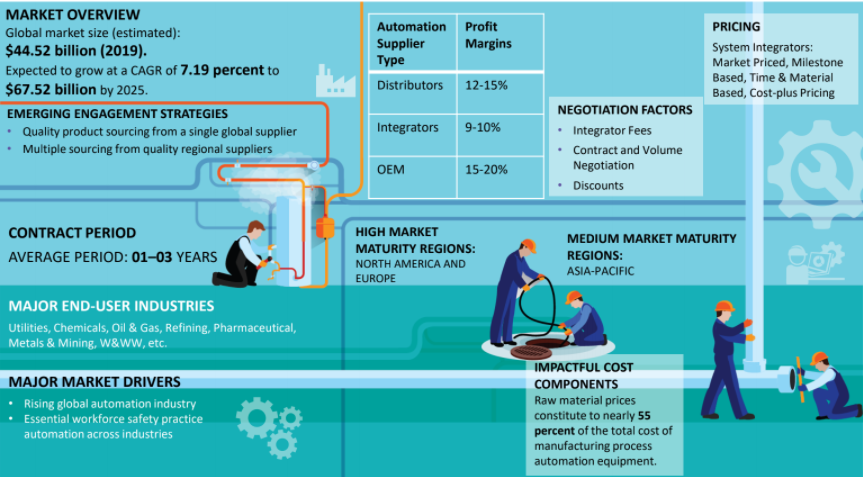CATEGORY
Process Instrumentation and Measurement
Instrumentation is a collective term for measuring instruments used for indicating, measuring and recording physical quantities. Measurement - to show measured results using values and symbols. Process Instrumentation and Measurement is an integral part of any process industry because it allows real time measurement and control of process variables such as levels, flow, pressure, temperature, pH and humidity.
Beroe LiVE.Ai™
AI-powered self-service platform for all your sourcing decision needs across 1,200+ categories like Process Instrumentation and Measurement.
Market Data, Sourcing & Supplier Intelligence, and Price & Cost Benchmarking.
Schedule a DemoProcess Instrumentation and Measurement Industry Benchmarks
Savings Achieved
(in %)
The average annual savings achieved in Process Instrumentation and Measurement category is 6.60%
Payment Terms
(in days)
The industry average payment terms in Process Instrumentation and Measurement category for the current quarter is 71.6 days
Compare your category performance against peers and industry benchmarks across 20+ parameters on Beroe LiVE.Ai™
Category Strategy and Flexibility
Engagement Model
Supply Assurance
Sourcing Process
Supplier Type
Pricing Model
Contract Length
SLAs/KPIs
Lead Time
Supplier Diversity
Targeted Savings
Risk Mitigation
Financial Risk
Sanctions
AMEs
Geopolitical Risk
Cost Optimization
Price per Unit Competitiveness
Specification Leanness
Minimum Order Quality
Payment Terms
Inventory Control
The World’s first Digital Market Analyst
Abi, the AI-powered digital assistant brings together data, insights, and intelligence for faster answers to sourcing questions
Abi is now supercharged with GPT4 AI engine. Enjoy the ease of ChatGPT, now on Abi
Process Instrumentation and Measurement Suppliers

Find the right-fit process instrumentation and measurement supplier for your specific business needs and filter by location, industry, category, revenue, certifications, and more on Beroe LiVE.Ai™.
Schedule a Demo


Use the Process Instrumentation and Measurement market, supplier and price information for category strategy creation and Quaterly Business Reviews (QRBs)
Schedule a DemoProcess Instrumentation and Measurement market report transcript
Process Instrumentation and Measurement Regional Market Outlook
-
Europe is expected to continue to dominate the market, in terms of growth prospects in adopting automation; however, APAC is growing at a competitive rate as well
-
Increasing focus on adopting automation across all industry verticals and spending more on new technologies are expected to be major drivers for the coming few years

Process Instrumentation and Measurement Demand Market Outlook
-
Process instrumentation equipment application is in a wide range of end-use industries. Process instrumentation equipment enables a plenty of benefits, including improvement in the quality of the product, safety, emission control, repeatability, accuracy, waste reduction, and cost savings. The current modern technology manufacturing, robotics, etc., cannot be imagined without sophisticated instruments
-
The market of process instrumentation equipment is driven by the increasing demand for automation technologies, Industry Internet of Things, Industry 4.0, digitization, BIG data, analytics, etc. Efficient measurement and control, data collection lies at the heart for the success of the above technologies. Also, cost and energy efficiency, asset utilization and reduction in engineering time are few of the major factors driving the growth of the process instrumentation market
Global PIM Market Maturity
-
The PIM market is fragmented and is competitively catering to a variety of industries with vast end-user segments across industries, such as utilities, chemicals, refining, pharmaceuticals, W&WW, food, etc.
Global PIM Industry Trends
-
Increasing levels of focus on high-quality PIM equipment in the developed regions, like North America and Western Europe, such as heavy-duty dust-tight enclosures, remote-mounted transmitters, etc., signal an increasing buyer maturity and willingness to partner with process control industry suppliers
-
Global suppliers of PIM are entering new geographies in developing regions, such as Chile, Brazil, India, etc., through M&A, thus offering multi-location solutions to global buyers
-
The fragmented automation market in APAC and LATAM has proven to be a big opportunity for global automation OEMs and service providers to tap into this market, thus, boosting the market for PIM.
Global PIM Market Overview
-
The global PIM market is expected to be at $45 billion in 2023 and grow at a CAGR of 5.18 percent from 2021 to 2025
-
The global process instrumentation market accounts for 30–35 percent of the global process automation market. With a rising adoption of automation across various industry verticals, growth of the PIM market is also paved simultaneously
Global Process Instrumentation Market Size (in US $ Billion)
-
The global PIM market is driven by technological innovations and increasing demands for automation. Also, cost efficiency, reduction in engineering time, asset utilization, and energy efficiency are some of the major factors driving the growth of the PIM market
-
Automation companies are trying to mitigate the impact of semiconductor chip shortages by sourcing alternative components, purchasing more than usual and being flexible and improvisational.
-
As Russia and Ukraine are major exporters of raw materials such as Neon, palladium and platinum and it is critical for chip manufacturing, prolonged supply disruption due to war will worsen the existing chip shortage issue.
Global PIM Market by Components (2023 E)
-
Field instruments are critical products often supporting 24×7 manufacturing processes, and quality is a very essential parameter
-
Control valves are very important to increase efficiency, safety, and profitability of process industries
-
Global process industries use different types of field instruments for monitoring and controlling their plants. The amount of benefit businesses reap from process instruments, such as improvement in product quality, emission reduction, reduction in human errors, and cost savings, etc., which are offering more growth opportunities to the PIM market
Cost Structure of Process Instruments
-
Major cost components of a measurement instrument are the cost of parts (which includes the cost of raw material) and the labor, while in the case of an automation control system (e.g., PLC, DCS), the major cost drivers will be the cost of system integration, system validation and design/engineering cost.
-
Complete pricing of an automation project depends on different phases of engaging with an OEM (for product/integration or both), an integrator (for technical consultation/integration of the entire process), end-user benefits (validation/testing) etc. of the complete solution.
-
Variation and increased complexity of design in customization increases the cost of a project
Why Should You Buy This Report
- Information about process instrumentation market overview, industry trends, maturity, regional market outlook, etc.
- Porter’s five force analysis of the global process instrumentation market.
- Supplier trends and insights, profiles, product portfolio, etc.
- SWOT analysis of major players like Siemens, Emerson Electric, and ABB Ltd.
- Cost structure analysis, cost breakup, cost saving strategies, pricing models.
- Automation and instrumentation procurement intelligence including best sourcing models, engagement practices, etc.
Interesting Reads:
Discover the world of market intelligence and how it can elevate your business strategies.
Learn more about how market intelligence can enable informed decision-making, help identify growth opportunities, manage risks, and shape your business's strategic direction.
Get Ahead with AI-Enabled Market Insights Schedule a Demo Now
